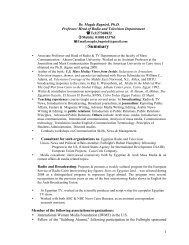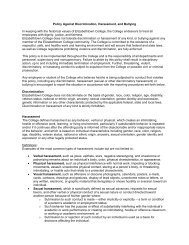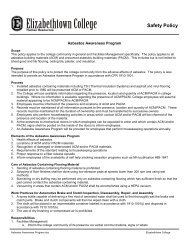Practice Algebra Test
Practice Algebra Test
Practice Algebra Test
Create successful ePaper yourself
Turn your PDF publications into a flip-book with our unique Google optimized e-Paper software.
◭◭ ◮◮ ◭ ◮ Back ◭ Doc Doc ◮<br />
<strong>Practice</strong> <strong>Algebra</strong> <strong>Test</strong><br />
Instructions:<br />
• Read each problem carefully. Then work the problem on a separate sheet<br />
of paper and click on the box next to the correct choice. If you change your<br />
mind, just click on a different choice.<br />
• Use the navigational buttons at the bottom of each page to go to the next<br />
or previous page.<br />
• A calculator is not required for any questions on this test.<br />
• This practice test consists of 25 problems. Click on “Begin Quiz”, then<br />
begin.<br />
1<br />
1. Graph {x| x < −3 or x > −1}<br />
2. Simplify: −3 + 5 [6 − 4(−2 − 7)]<br />
−147 −36 63 207
◭◭ ◮◮ ◭ ◮ Back ◭ Doc Doc ◮<br />
2<br />
3. Subtract 3 4<br />
from the product of −9 and<br />
5<br />
36 .<br />
− 1 2<br />
−2 − 3 4<br />
7<br />
4<br />
4. Company X’s shipping rate is $.35 for each of the first 5 ounces, and<br />
$.10 for each additional ounce. What would it cost to ship a 12 ounce<br />
package?<br />
$1.05 $1.20 $2.45 $3.00<br />
5. Solve 3 2 (8x − 9) + 5 2 = 13<br />
− 11 6<br />
−1<br />
5<br />
2<br />
2<br />
6. 2 −5 · 64 2/3 =<br />
1<br />
1<br />
512<br />
512<br />
1<br />
2<br />
7. Solve: −7(2x − 3) ≤ −5(3x − 4)<br />
x ≤ −1 x ≤ 2 x ≤ −2 x ≥ 1<br />
8. Solve: |2x − 5| − 1 > 2<br />
x > −1 or x < 4 x > 1 or x < 4<br />
x > 4 or x < 1<br />
x > 4 or x < −1
◭◭ ◮◮ ◭ ◮ Back ◭ Doc Doc ◮<br />
9. Simplify, write answers with positive exponents:<br />
x 3<br />
y 5<br />
( x −6 y −2<br />
x −3 y −3 ) −1<br />
y<br />
1<br />
x 3<br />
x 3 x 3 y 5 y<br />
( 7<br />
10. Simplify:<br />
12 x3 − 2 5 x2 + 8 ) ( 7<br />
−<br />
9 20 x2 + 1 6 x − 5 )<br />
18<br />
7<br />
12 x3 − 3 4 x2 + 1 6 x + 11<br />
7<br />
18<br />
12 x3 − 1<br />
20 x2 + 1 6 x + 11<br />
18<br />
7<br />
12 x3 − 1<br />
20 x2 − 1 6 x + 7 6<br />
7<br />
12 x3 − 3 4 x2 − 1 6 x + 7 6<br />
3<br />
11. One of the factors of 10x 2 − x − 21 is<br />
2x + 3 5x + 7 5x + 3 10x − 1<br />
12. What is the sum of the solutions of x 3 − 4x = 0?<br />
0 −1 1 2
◭◭ ◮◮ ◭ ◮ Back ◭ Doc Doc ◮<br />
4<br />
13. x2 + 8x + 16<br />
x 2 − 3x − 28 =<br />
x − 4<br />
x + 4<br />
x + 4<br />
x − 7<br />
x + 8<br />
x − 3<br />
x + 8<br />
x − 7<br />
10<br />
14. Solve:<br />
a − 8 = 6<br />
a − 2<br />
17<br />
4<br />
4<br />
−7 −2<br />
15. √ 64x + 3 √ x =<br />
√<br />
73x 4<br />
√<br />
65x 11<br />
√ x<br />
√<br />
67x<br />
16.<br />
4x<br />
x 2 − 49 − 2<br />
x + 7 =<br />
2<br />
x − 7<br />
4x − 2<br />
x 2 − 49<br />
1<br />
x + 7<br />
1<br />
x − 7<br />
17. A student has 75 coins worth a total of $10.65. Each coin is either a<br />
dime (10 cents) or a quarter (25 cents). If x is the number of dimes,<br />
then x can be determined from the equation<br />
0.10x + 0.25(75 − x) = 10.65<br />
x<br />
0.10 + 75−x<br />
0.25 = 10.65<br />
75x = 10.65 0.10 + 0.25(75 − x) = 10.65
◭◭ ◮◮ ◭ ◮ Back ◭ Doc Doc ◮<br />
18. What is the area, in square centimeters, of a rectangle with perimeter<br />
of 56 cm if the length is 4 cm less than three times the width?<br />
76 104 132 160<br />
19. ( −x 2 y −3) ( −2x 2 y 4) 3<br />
=<br />
−2x 8 y 9 8x 7 y 4 8x 8 y 9 8x 7 y 10<br />
20. The slope of the line that goes through the points (−5, 4) and (3, −12)<br />
is<br />
− 1 8 −2 4<br />
2<br />
21. Solve the equation 3x − 2 = 2 ( 1<br />
2 − 1 3 x)<br />
x = − 1<br />
11<br />
x = 1 9<br />
x = 9<br />
11<br />
x = 9 7<br />
5<br />
22. Find all solutions to the equation 3x 2 = 4x + 1<br />
2+<br />
4/3, 1/3 √ 7<br />
3<br />
, 2−√ 7<br />
3<br />
4+3 √ 2<br />
6<br />
, 4−3√ 2<br />
6<br />
2+ √ 2<br />
3<br />
, 2−√ 2<br />
3<br />
23. In the system of equations<br />
{ 2x − 3y = 3<br />
4x + 2y = 2<br />
y = −1/2 y = −1 y = −1/4 y = 0
◭◭ ◮◮ ◭ ◮ Back ◭ Doc Doc ◮<br />
6<br />
24. If 4x = 1 + √ 2x + 1 then x =<br />
3<br />
2<br />
3<br />
4<br />
5<br />
8<br />
5<br />
16<br />
25. The sum of the x and y intercepts of the line that passes through the<br />
two points (−2, 5) and (8, 10) is<br />
12 −6 6 0<br />
• Click on “End Quiz” to have the computer grade your test. Then click<br />
on “Correct My Answers” to see which questions you got wrong.<br />
• Click on the green dots to see detailed solutions for each problem.
◭◭ ◮◮ ◭ ◮ Back ◭ Doc Doc ◮<br />
Solutions to <strong>Practice</strong> <strong>Test</strong>s 7<br />
Solutions to <strong>Practice</strong> <strong>Algebra</strong> <strong>Test</strong><br />
Solution to Question 1: The solution is<br />
Return
◭◭ ◮◮ ◭ ◮ Back ◭ Doc Doc ◮<br />
Solutions to <strong>Practice</strong> <strong>Test</strong>s 8<br />
Solution to Question 2: −3 + 5 [6 − 4(−2 − 7)] = −3 + 5 [6 − 4(−9)] =<br />
−3 + 5 [6 + 36] = −3 + 5(42) = −3 + 210 = 207<br />
Return
◭◭ ◮◮ ◭ ◮ Back ◭ Doc Doc ◮<br />
Solutions to <strong>Practice</strong> <strong>Test</strong>s 9<br />
Solution to Question 3: (−9) · ( )<br />
5<br />
36 = −<br />
5<br />
4 , so − 5 4 − 3 4 = − 8 4 = −2.<br />
Return
◭◭ ◮◮ ◭ ◮ Back ◭ Doc Doc ◮<br />
Solutions to <strong>Practice</strong> <strong>Test</strong>s 10<br />
Solution to Question 4: The first 5 ounces cost (.35)(5) = 1.75. The next<br />
12−5 = 7 ounces cost (.10)(7) = 0.70, so the total cost is 1.75+0.70 = $2.45.<br />
Return
◭◭ ◮◮ ◭ ◮ Back ◭ Doc Doc ◮<br />
Solutions to <strong>Practice</strong> <strong>Test</strong>s 11<br />
Solution to Question 5: Multiplying both sides of the equation 3 2 (8x −<br />
9) + 5 2<br />
= 13 by 2 we obtain<br />
3(8x − 9) + 5 = 26 ⇒ 24x − 27 + 5 = 26<br />
⇒ 24x − 22 = 26<br />
⇒ 24x = 48<br />
⇒ x = 2<br />
Return
◭◭ ◮◮ ◭ ◮ Back ◭ Doc Doc ◮<br />
Solutions to <strong>Practice</strong> <strong>Test</strong>s 12<br />
Solution to Question 6: 2 −5 = 1 2 5 = 1<br />
32 and 642/3 = ( √ 3<br />
64 ) 2<br />
= (4) 2 =<br />
16, so 2 −5 · 64 2/3 = 1 16<br />
32 · 16 =<br />
32 = 1 2 . Return
◭◭ ◮◮ ◭ ◮ Back ◭ Doc Doc ◮<br />
Solutions to <strong>Practice</strong> <strong>Test</strong>s 13<br />
Solution to Question 7:<br />
−7(2x − 3) ≤ −5(3x − 4)<br />
⇒ −14x + 21 ≤ −15x + 20<br />
⇒ x ≤ −1<br />
Return
◭◭ ◮◮ ◭ ◮ Back ◭ Doc Doc ◮<br />
Solutions to <strong>Practice</strong> <strong>Test</strong>s 14<br />
Solution to Question 8:<br />
|2x − 5| − 1 > 2<br />
⇒ |2x − 5| > 3<br />
⇒ 2x − 5 > 3 or 2x − 5 < −3<br />
⇒ 2x > 8 or 2x < 2<br />
⇒ x > 4 or x < 1<br />
Return
◭◭ ◮◮ ◭ ◮ Back ◭ Doc Doc ◮<br />
Solutions to <strong>Practice</strong> <strong>Test</strong>s 15<br />
( ) −1<br />
Solution to Question 9: x−6 y −2<br />
x −3 y<br />
= x3 y 3<br />
−3 x 6 y<br />
= y 2 x<br />
so x −6 y −2<br />
3 x −3 y =<br />
x 3<br />
−3 y .<br />
Return
◭◭ ◮◮ ◭ ◮ Back ◭ Doc Doc ◮<br />
Solutions to <strong>Practice</strong> <strong>Test</strong>s 16<br />
Solution to Question 10:<br />
( 7<br />
12 x3 − 2 5 x2 + 8 ) ( 7<br />
−<br />
9 20 x2 + 1 6 x − 5 )<br />
18<br />
= 7 (<br />
12 x3 + − 2 5 − 7 )<br />
x 2 − 1 ( 8<br />
20 6 x + 9 + 5 )<br />
18<br />
= 7 (<br />
12 x3 + − 8<br />
20 − 7 )<br />
x 2 − 1 ( 16<br />
20 6 x + 18 + 5 )<br />
18<br />
= 7 (<br />
12 x3 + − 15 )<br />
x 2 − 1 20 6 x + 21<br />
18<br />
= 7 12 x3 − 3 4 x2 − 1 6 x + 7 6<br />
Return
◭◭ ◮◮ ◭ ◮ Back ◭ Doc Doc ◮<br />
Solutions to <strong>Practice</strong> <strong>Test</strong>s 17<br />
Solution to Question 11: 10x 2 − x − 21 = (2x − 3)(5x + 7)<br />
Return
◭◭ ◮◮ ◭ ◮ Back ◭ Doc Doc ◮<br />
Solutions to <strong>Practice</strong> <strong>Test</strong>s 18<br />
Solution to Question 12: x 3 − 4x = x(x 2 − 4) = x(x − 2)(x + 2) so the<br />
solutions are x = 0, 2, −2 and so the sum is 0.<br />
Return
◭◭ ◮◮ ◭ ◮ Back ◭ Doc Doc ◮<br />
Solutions to <strong>Practice</strong> <strong>Test</strong>s 19<br />
Solution to Question 13:<br />
x 2 + 8x + 16 (x + 4)(x + 4)<br />
x 2 =<br />
− 3x − 28 (x − 7)(x + 4) = x + 4<br />
x − 7<br />
Return
◭◭ ◮◮ ◭ ◮ Back ◭ Doc Doc ◮<br />
Solutions to <strong>Practice</strong> <strong>Test</strong>s 20<br />
Solution to Question 14: Cross-multiplying we have<br />
10(a − 2) = 6(a − 8)<br />
⇒ 10a − 20 = 6a − 48<br />
⇒ 4x = −28 ⇒ 4a = −28<br />
⇒ a = −7<br />
Return
◭◭ ◮◮ ◭ ◮ Back ◭ Doc Doc ◮<br />
Solutions to <strong>Practice</strong> <strong>Test</strong>s 21<br />
Solution to Question 15:<br />
√<br />
64x + 3<br />
√ x = 8<br />
√ x + 3<br />
√ x = 11<br />
√ x<br />
Return
◭◭ ◮◮ ◭ ◮ Back ◭ Doc Doc ◮<br />
Solutions to <strong>Practice</strong> <strong>Test</strong>s 22<br />
Solution to Question 16: A common denominator is x 2 − 49.<br />
2<br />
x+7 = 2<br />
x+7 · x−7<br />
x−7 = 2(x−7)<br />
x 2 −49 = 2x−14<br />
x 2 −49 . So<br />
Then<br />
4x<br />
x 2 − 49 − 2<br />
x + 7<br />
=<br />
=<br />
=<br />
=<br />
=<br />
=<br />
4x 2x − 14<br />
x 2 −<br />
− 49 x 2 − 49<br />
4x − (2x − 14)<br />
x 2 − 49<br />
4x − 2x + 14<br />
x 2 − 49<br />
2x + 14<br />
x 2 − 49<br />
2(x + 7)<br />
(x + 7)(x − 7)<br />
2<br />
x − 7<br />
Return
◭◭ ◮◮ ◭ ◮ Back ◭ Doc Doc ◮<br />
Solutions to <strong>Practice</strong> <strong>Test</strong>s 23<br />
Solution to Question 17: If x is the number of dimes, that .10x is their<br />
worth. Since there are 75 coins altogether, the number of quarters must be<br />
75 − x and their worth is .25(75 − x). Hence the total worth of the coins is<br />
.10x + .25(75 − x) and this must equal 10.65. Return
◭◭ ◮◮ ◭ ◮ Back ◭ Doc Doc ◮<br />
Solutions to <strong>Practice</strong> <strong>Test</strong>s 24<br />
Solution to Question 18: Let l and w be the length and width of the<br />
rectangle. Then l = 3w − 4 and 2l + 2w = 56. So l + w = 28 and so<br />
3w − 4 = l = 28 − w ⇒ 4w = 32 ⇒ w = 8 and so l = 20. So the area of the<br />
rectangle is l · w = (20)(8) = 160 square centimeters.<br />
Return
◭◭ ◮◮ ◭ ◮ Back ◭ Doc Doc ◮<br />
Solutions to <strong>Practice</strong> <strong>Test</strong>s 25<br />
Solution to Question 19: ( −x 2 y −3) ( −2x 2 y 4) 3 (<br />
= −x 2 y −3) ( −8x 6 y 12) =<br />
8x 8 y 9 .<br />
Return
◭◭ ◮◮ ◭ ◮ Back ◭ Doc Doc ◮<br />
Solutions to <strong>Practice</strong> <strong>Test</strong>s 26<br />
Solution to Question 20: The slope is<br />
y 2 − y 1<br />
= −12 − 4<br />
x 2 − x 1 3 − (−5) = −16 = −2<br />
8<br />
Return
◭◭ ◮◮ ◭ ◮ Back ◭ Doc Doc ◮<br />
Solutions to <strong>Practice</strong> <strong>Test</strong>s 27<br />
Solution to Question 21: Multiplying both sides of the equation by 6 we<br />
have 18x−12 = 2(3−2x) = 6−4x ⇒ 22x = 18 ⇒ x = 18<br />
22 = 9<br />
11 . Return
◭◭ ◮◮ ◭ ◮ Back ◭ Doc Doc ◮<br />
Solutions to <strong>Practice</strong> <strong>Test</strong>s 28<br />
Solution to Question 22: We use the quadratic formula to solve the<br />
equation 3x 2 − 4x − 1 = 0 with a = 3, b = −4, and c = −1. So<br />
x = −b ± √ b 2 − 4ac<br />
2a<br />
= 4 ± √ 16 + 12<br />
6<br />
= 4 ± √ 28<br />
6<br />
= 4 ± 2√ 7<br />
6<br />
= 2 ± √ 7<br />
3<br />
So the solutions are 2+√ 7<br />
3<br />
and 2−√ 7<br />
3<br />
. Return
◭◭ ◮◮ ◭ ◮ Back ◭ Doc Doc ◮<br />
Solutions to <strong>Practice</strong> <strong>Test</strong>s 29<br />
Solution to Question 23: If we multiply the first equation by −2 we<br />
obtain −4x + 6y = −6. Then adding this equation to the second equation<br />
4x + 2y = 2 we obtain 8y = −4 or y = − 1 2 .<br />
Return
◭◭ ◮◮ ◭ ◮ Back ◭ Doc Doc ◮<br />
Solutions to <strong>Practice</strong> <strong>Test</strong>s 30<br />
Solution<br />
√<br />
to Question 24: If we square both sides of the equation 4x−1 =<br />
2x + 1 we find that 16x 2 − 8x + 1 = 2x + 1 ⇒ 16x 2 − 10x = 0 =<br />
2x(8x − 5) ⇒ x = 0 or x = 5 8 . We see that x = 0 is not a solution<br />
since 0 ≠ 2, so the only solution is x = 5 8 .<br />
Return
Solutions to <strong>Practice</strong> <strong>Test</strong>s 31<br />
Solution to Question 25: The slope of this line is 10−5<br />
8+2 = 5<br />
10 = 1 2 . The<br />
equation of the line then is y = 1 2x + b. If we plug in one of the points,<br />
say x = −2 and y = 5, we have 5 = 1 2<br />
(−2) + b = −1 + b ⇒ b = 6. So the<br />
equation of this line is y = 1 2x + 6. If x = 0 then y = 6 (the y intercept).<br />
If y = 0 then 0 = 1 2 x + 6 ⇒ −6 = 1 2x ⇒ x = −12 (the x intercept). Hence<br />
the sum of the two intercepts is 6 − 12 = −6.<br />
Return









